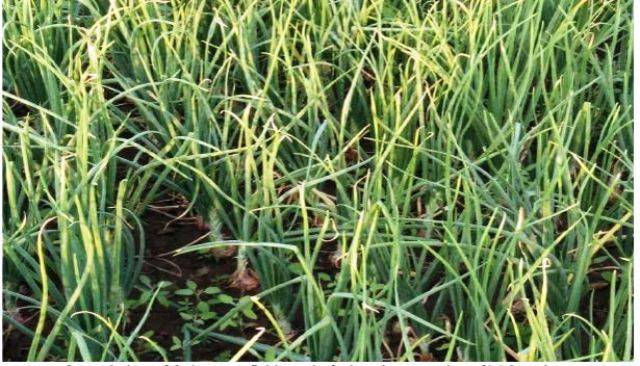
Onion (Allium cepa) is one of the second most important commercial crops of the India which is next to Potato. In the world, Onion crop is grown in about 5.30 million hectare area with an annual production of 88.48 million tons with productivity 16.70 tons per hectare. China stands first in the Onion production (22.61 million tons from an area 1.03 million hectares area) in the world with productivity 21.85 tons per hectare followed by India. In India, Onion crop is grown in about 1.20 million hectare area with an annual production of 19.40 million tons with productivity 16.12 tons per hectare. The quantity of Onion 2415.75 thousand tons is exported from India which outputs value of 3, 10,650.09 Rs. lakhs. (Anon, 2017).

Summer /rabi Onion farming
Summer/ rabi Onion is more commonly practiced for an irrigated crop, resulting in a high yield with large sized bulbs. Seedlings are first raised in the nursery. For summer/ rabi crop in India October to November is recomonded as sowing time. In Maharashtra it is transplanted during November to December. (Anon, 2018).
About 10 to 12 Kg. seed is required to raise seedlings for one hectare transplanting. The seedlings are ready for transplanting 45-60 days after sowing. Over-aged seedlings result in bolting, taking longer time to start new growth. The spacing 15 x 10 cm. (row to plant) is recomonded for optimum population and higher yield.
Nutrition
Onion needs a heavy dose of fertilizers for good yield. However, fertilizer a requirement is depends upon soil type and varieties etc. Completely decomposed organic manure @ 25 to 30 tons per hectare may be incorporated into the soil 15 days before transplanting. For one hectare, 108 Kg. Urea, 312 Kg. Single super phosphate and 83 Kg. Murate of potash to be applied at transplanting and again 108 Kg. Urea to be added equally into two splits at 30 and 45 days after transplanting. Forty five days after planting, no any N containing fertilizers should be applied.
Sulphur @ 45 Kg. in the form of Gypsum to be added per hectare into the soil 15 days before transplanting. (Anon, 2018).


(Dr. Sable P. A. (Scientist), Dr. Hari More (Ex. Dir. Ext. Edu., MPKV, Rahuri) and Professor Rajendra Lipane with Onion growers in the field of Ahmednagar region of Maharashtra).
Weed management
As Onion plants are closely spaced and roots are shallow, it is essential to keep the crop weed free, especially 30 to 45 days from translating. Crop weed competition is recorded to higher from transplanting till almost 45 days, it may reduce yield up to 60 percents. Therefore, Oxifluorfen (24 % EC.) 1 to 1.25 ml. per liter of water (before 2 days of transplanting or within one week after transplanting) followed by one hand weeding at 30 to 45 days after transplanting is recomonded for effective weed control. (Sable et al., 2014).
Plant protection
Onion thrips (Thrips tabaci) is most destructive pests and Blight is severe disease of Onion. Spray fipronil 1.5 ml. with 1 ml. sticker per liter of water for effective control of thrips. Spray of Mencozeb 2.5 g. per liter of water is found to effective to control Onion Blight or Dithane M-45 @ 3 g. per liter of water is also found effective. These fungicides should be sprayed with 1 ml. sticker per liter of water, alternatively at 10 to 15 days intervals. (Anon, 2018) and Krushi Salla, Agrowone news paper, 1 March, 2018 of Maharashtra.
Reference
Anonymous (2018). Directorate of Extension Education, Mahatma Phule Krishi
Vidyapeeth, Rahuri (MS). Krushidarshni.
Anonymous (2017). Horticultural Statistics at a Glance, 2017, Pp. 16, 454 and 470.
Krushi Salla, Onion plant protection, Agrowone news paper (Maharashtra) 1 March, 2018.
Dr Sable P. A, A. S. Purane and S. N. Jadhav (2014). Studies on integrated weed management in Onion. Bioinfolet 11 (2 B) Pp. 429-31.
Writers:
Dr. Sable P. A., Assistant Professor (Horticulture), Sardarkrushinagar Dantiwada Agricultural University, S. K. Nagar, Gujarat and Sushma Sonpure, Sr. Ph.D. Scholar (Agronomy),
Mahatma Phule Krishi Vidyapeeth, Rahuri, Maharashtra.















